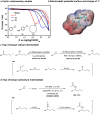Electrochemical C-C bond cleavage of cyclopropanes towards the synthesis of 1,3-difunctionalized molecules
- PMID: 34031421
- PMCID: PMC8144616
- DOI: 10.1038/s41467-021-23401-8
Electrochemical C-C bond cleavage of cyclopropanes towards the synthesis of 1,3-difunctionalized molecules
Abstract
Electrochemistry has a lot of inherent advantages in organic synthesis and many redox reactions have been achieved under electrochemical condition. However, the electrochemical C-C bond cleavage and functionalization reactions are less studied. Here we develop electrochemical C-C bond cleavage and 1,3-difuntionalization of arylcyclopropanes under catalyst-free and external-oxidant-free conditions. 1,3-difluorination, 1,3-oxyfluorination and 1,3-dioxygenation of arylcyclopropanes are achieved with a high chemo- and regioselectivity by the strategic choice of nucleophiles. This protocol has good functional groups tolerance and can be scaled up. Mechanistic studies demonstrate that arylcyclopropane radical cation obtained from the anode oxidation and the subsequently generated benzyl carbonium are the key intermediates in this transformation. This development provides a scenario for constructing 1,3-difunctionalized molecules.
Conflict of interest statement
The authors declare no competing interests.
Figures





Similar articles
-
Electrochemical Formation of Oxazolines by 1,3-Oxyfluorination of Non-activated Cyclopropanes.Org Lett. 2024 Mar 22;26(11):2158-2162. doi: 10.1021/acs.orglett.4c00143. Epub 2024 Mar 8. Org Lett. 2024. PMID: 38456832
-
Copper-Catalyzed Aerobic Oxidations of Organic Molecules: Pathways for Two-Electron Oxidation with a Four-Electron Oxidant and a One-Electron Redox-Active Catalyst.Acc Chem Res. 2015 Jun 16;48(6):1756-66. doi: 10.1021/acs.accounts.5b00060. Epub 2015 May 28. Acc Chem Res. 2015. PMID: 26020118
-
Electrochemical 1,3-Alkyloxylimidation of Arylcyclopropane Radical Cations: Four-Component Access to Imide Derivatives.Org Lett. 2023 Sep 22;25(37):6919-6924. doi: 10.1021/acs.orglett.3c02744. Epub 2023 Sep 11. Org Lett. 2023. PMID: 37695045
-
Arylcyclopropane yet in its infancy: the challenges and recent advances in its functionalization.Org Biomol Chem. 2021 Oct 20;19(40):8627-8645. doi: 10.1039/d1ob01432c. Org Biomol Chem. 2021. PMID: 34549770 Review.
-
Recent advances in metal catalyst- and oxidant-free electrochemical C-H bond functionalization of nitrogen-containing heterocycles.Front Chem. 2022 Aug 19;10:967501. doi: 10.3389/fchem.2022.967501. eCollection 2022. Front Chem. 2022. PMID: 36059873 Free PMC article. Review.
Cited by
-
Remote Radical 1,3-, 1,4-, 1,5-, 1,6- and 1,7-Difunctionalization Reactions.Molecules. 2023 Mar 28;28(7):3027. doi: 10.3390/molecules28073027. Molecules. 2023. PMID: 37049790 Free PMC article. Review.
-
Electrochemical Deconstructive Methoxylation of Arylalcohols-A Synthetic and Mechanistic Investigation.Chemistry. 2024 Nov 21;30(65):e202403413. doi: 10.1002/chem.202403413. Epub 2024 Oct 30. Chemistry. 2024. PMID: 39287365 Free PMC article.
-
A review of recent advances in electrochemical and photoelectrochemical late-stage functionalization classified by anodic oxidation, cathodic reduction, and paired electrolysis.Beilstein J Org Chem. 2024 Oct 9;20:2500-2566. doi: 10.3762/bjoc.20.214. eCollection 2024. Beilstein J Org Chem. 2024. PMID: 39403305 Free PMC article. Review.
-
Visible light-mediated organocatalyzed 1,3-aminoacylation of cyclopropane employing N-benzoyl saccharin as bifunctional reagent.Nat Commun. 2024 Oct 16;15(1):8930. doi: 10.1038/s41467-024-53202-8. Nat Commun. 2024. PMID: 39414792 Free PMC article.
-
Divergent Synthesis of β-Fluoroamides via Silver-Catalyzed Oxidative Deconstruction of Cyclopropanone Hemiaminals.Org Lett. 2023 Jul 21;25(28):5389-5394. doi: 10.1021/acs.orglett.3c01992. Epub 2023 Jul 6. Org Lett. 2023. PMID: 37413978 Free PMC article.
References
-
- Salaun J. Optically active cyclopropanes. Chem. Rev. 1989;89:1247–1270.
-
- Wong HNC, et al. Use of cyclopropanes and their derivatives in organic synthesis. Chem. Rev. 1989;89:165–198.
-
- Reissig H-U, Zimmer R. Donor−acceptor-substituted cyclopropane derivatives and their application in organic synthesis. Chem. Rev. 2003;103:1151–1196. - PubMed
Publication types
LinkOut - more resources
Full Text Sources
Other Literature Sources

